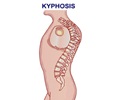Osteoporosis is a disease that is characterized by a reduction in the bone mass and density increasing the susceptibility to bone deformities and fractures
Osteoporosis is a disease that is characterized by a reduction in the bone mass and density increasing the susceptibility to bone deformities and fractures. It affects approximately 10 million Americans above the age of 50 years. At the Harvard School of Public Health (HSPH), scientists have discovered that the removal of a protein, Schnurri-3 (Shn3) in mice led to a dramatic increase in their overall bone mass. The results may have profound implications in the treatment of osteoporosis. Their study was published in the May 26 edition of the journal, Science.
Osteoporosis has serious health consequences. One-fifth of patients with osteoporosis who fracture their hips will die within a year. As the baby boomer generation gets older, it is predicted that the number of hip fractures may triple by 2020 unless better prevention and treatment for the disease is improved.The researchers, led by Dallas Jones, a research associate in the Department of Immunology and Infectious Diseases, Marc Wein, an MD, PhD student, and senior author Laurie Glimcher, Professor of Immunology, observed that augmented osteoblast activity, rather than impaired osteoblast activity, was responsible for the elevated bone mass. Osteoblasts are cells that form new bone. Jones, Wein and their colleagues found that Shn3 formed a complex with a protein known as WWP1; together, the pair degrades Runx2, a transcription factor that is the master regulator of osteoblast differentiation, which activates key bone formation genes. By removing Shn3 or WWP1, Runx2 doesnt degrade, which leads to increased bone mass.
The authors believe that targeting Shn3 and WWP1 for drug discovery is an exciting prospect. Glimcher's lab has forged a collaboration with Brandeis University biochemist Greg Petsko to find compounds that inhibit the two proteins, which could lead to new and better treatments for osteoporosis. Though the biggest hurdles of drug discovery lie in the distant future, said Petsko, 'as early stage targets go, this looks promising. It just smells like a good target.'
Source: Eurekalert











